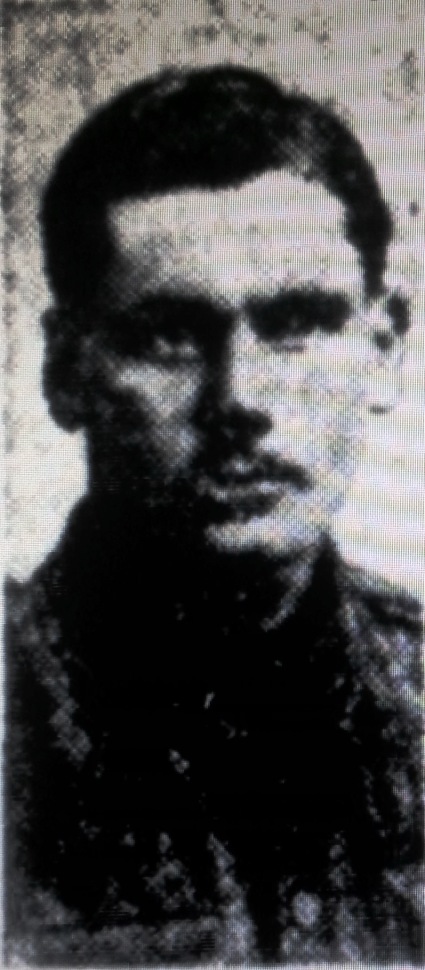Sgt
Arthur Alfred Baron Baldwin
Information about birth
|
Date of birth: 08/01/1895 |
|
Place of birth: Surry Hills, Sydney, New South Wales, Australia |
General information
|
Last known residence: 91 Salisbury Road, Stanmore, New South Wales, Australia |
|
Profession: Carpenter |
|
Religion: Church of England |
Army information
|
Country: Australia |
|
Force: Australian Imperial Force |
|
Rank: Sergeant |
|
Service number: 43 |
|
Enlistment date: 19/08/1914 |
|
Enlistment place: Paddington, Sydney, New South Wales, Australia |
|
Units: — Australian Engineers, 1st Field Coy. (Last known unit) |
Information about death
|
Date of death: 21/09/1917 |
|
Place of death: Lone House, Veldhoek, Belgium |
|
Cause of death: Killed in action (K.I.A.) |
|
Age: 22 |
Cemetery
|
Tyne Cot Cemetery Plot: XLII Row: F Grave: 21 |
Distinctions and medals 4
|
1914-15 Star Medal |
|
British War Medal Medal |
|
Order Of Karageorge, 3rd Class (Serbia) Medal |
|
Victory Medal Medal |
Points of interest 3
| #1 | Place of birth | ||
| #2 | Enlistment place | ||
| #3 | Place of death (approximate) |
My story
Arthur Alfred Baron Baldwin was born on January 8, 1895, in Surrey Hills, Sydney, New South Wales, Australia. He was the son of Kate Baldwin and Arthur John Baldwin. Before the war, he worked as a carpenter. Shortly after the outbreak of the war, on August 19, 1914, he decided to enlist. He was assigned to No. 1 Section of the 1st Field Company, Australian Engineers.
Arthur Alfred Baron Baldwin was killed in action at the age of 22 on September 21, 1917, during the Battle of Passchendaele.
That day, No. 1 Section was positioned near Hooge. There, they received orders to move towards the front line at Lone House, south of Polygon Wood. They arrived around 4 a.m. in the sector, which was manned by two platoons of A Company, 5th Australian Infantry Battalion. The engineers' task was to extend the communication trench running from Strong Point A. By 2 p.m., the trench was completed. Between 4 a.m. and 2 p.m., the engineers were repeatedly targeted by artillery and sniper fire.
Around 2:30 p.m., the engineers were ordered to return to Strong Point A for further construction work. Around the same time, a German bombardment began, which was most intense between 4:30 p.m. and 8:45 p.m. Later that evening, No. 1 Section was relieved by the 2nd Field Company, Australian Engineers. When the unit regrouped at Clapham Junction, it became clear that Sergeant Baldwin was still at Strong Point A near Lone House. Lieutenants McConnel and Lyddon decided to return with two others. They found four or five bodies but could not identify them due to the darkness. They returned to Hooge, planning to continue the search the next day.
Sergeant Baldwin fell victim to the bombardment between 4 p.m. and 7 p.m. that day. He was killed alongside Corporal Hamilton when a shell exploded near Strong Point A. Despite the bombardment, Baldwin did his best to maintain the men's morale by encouraging them throughout the ordeal.
His body was found near Lone House after the war and reburied at Tyne Cot Cemetery, Plot XLII, Row F, Grave 21.
Arthur Alfred Baron Baldwin was killed in action at the age of 22 on September 21, 1917, during the Battle of Passchendaele.
That day, No. 1 Section was positioned near Hooge. There, they received orders to move towards the front line at Lone House, south of Polygon Wood. They arrived around 4 a.m. in the sector, which was manned by two platoons of A Company, 5th Australian Infantry Battalion. The engineers' task was to extend the communication trench running from Strong Point A. By 2 p.m., the trench was completed. Between 4 a.m. and 2 p.m., the engineers were repeatedly targeted by artillery and sniper fire.
Around 2:30 p.m., the engineers were ordered to return to Strong Point A for further construction work. Around the same time, a German bombardment began, which was most intense between 4:30 p.m. and 8:45 p.m. Later that evening, No. 1 Section was relieved by the 2nd Field Company, Australian Engineers. When the unit regrouped at Clapham Junction, it became clear that Sergeant Baldwin was still at Strong Point A near Lone House. Lieutenants McConnel and Lyddon decided to return with two others. They found four or five bodies but could not identify them due to the darkness. They returned to Hooge, planning to continue the search the next day.
Sergeant Baldwin fell victim to the bombardment between 4 p.m. and 7 p.m. that day. He was killed alongside Corporal Hamilton when a shell exploded near Strong Point A. Despite the bombardment, Baldwin did his best to maintain the men's morale by encouraging them throughout the ordeal.
His body was found near Lone House after the war and reburied at Tyne Cot Cemetery, Plot XLII, Row F, Grave 21.
Sources 5
|
1st Field Company, Australian Engineers, (Australian War Memorial, Campbell (AWM), AWM4 14/20/33). https://www.awm.gov.au/ Sources used |
|
Australian Red Cross Wounded and Missing Enquiry Bureau (Australian War Memorial, Campbell (AWM), RCDIG1037776). https://www.awm.gov.au/ Sources used |
|
First Australian Imperial Force Personnel Dossiers, 1914-1920, (National Archives of Australia, Canberra (NAA), B2455, BALDWIN A A B). https://www.naa.gov.au/ Sources used |
|
Sydney, Australia, Anglican Parish Registers, 1814-2011 (The Sydney Diocesan Archives, Sydney). http://www.sydneyanglicanarchives.com.au/home.html Sources used |
|
Unit embarkation nominal rolls, 1914-18 War (Australian War Memorial, Campbell (AWM), AWM8 14/20/1). https://www.awm.gov.au/ Sources used |
More information 4
|
Commonwealth War Graves Commission Database https://www.cwgc.org/find-records/find-war-dead/casualty-details/461805 |
|
The AIF Project (UNSW Canberra) https://aif.adfa.edu.au/showPerson?pid=11887 |
|
Namenlijst (In Flanders Fields Museum) https://namenlijst.org/publicsearch/#/person/_id=5d03fee3-124e-4ee6-9dd1-502b79bf7320 |
|
Lives of the First World War (Imperial War Museum) https://livesofthefirstworldwar.iwm.org.uk/lifestory/7348251 |
